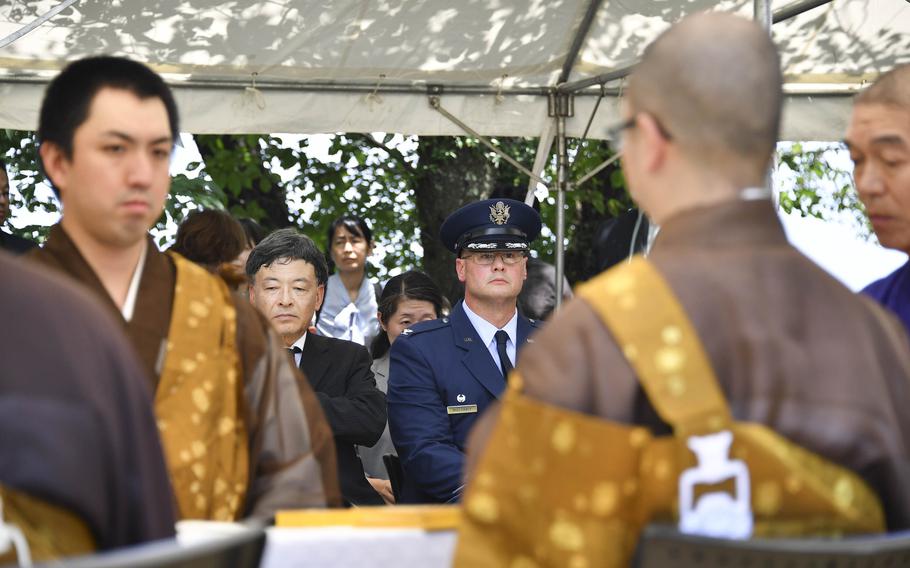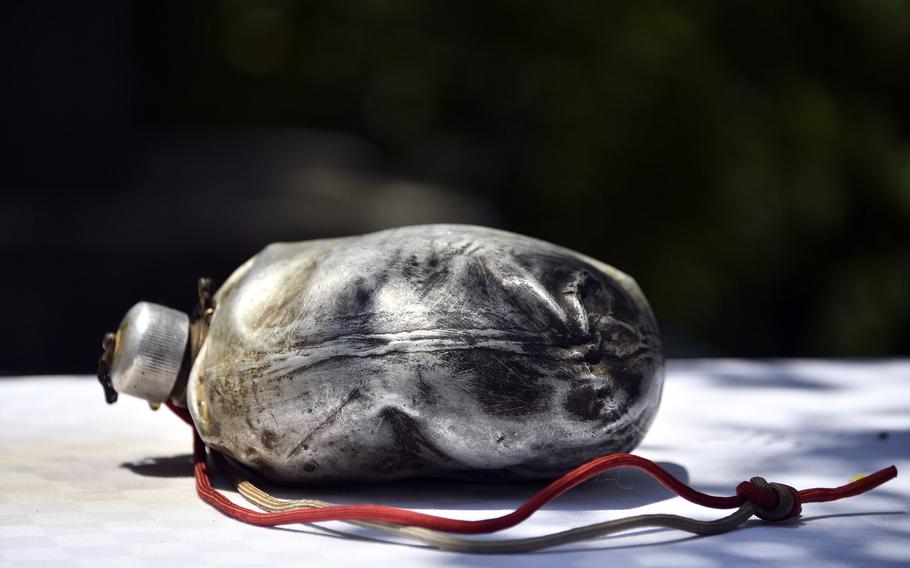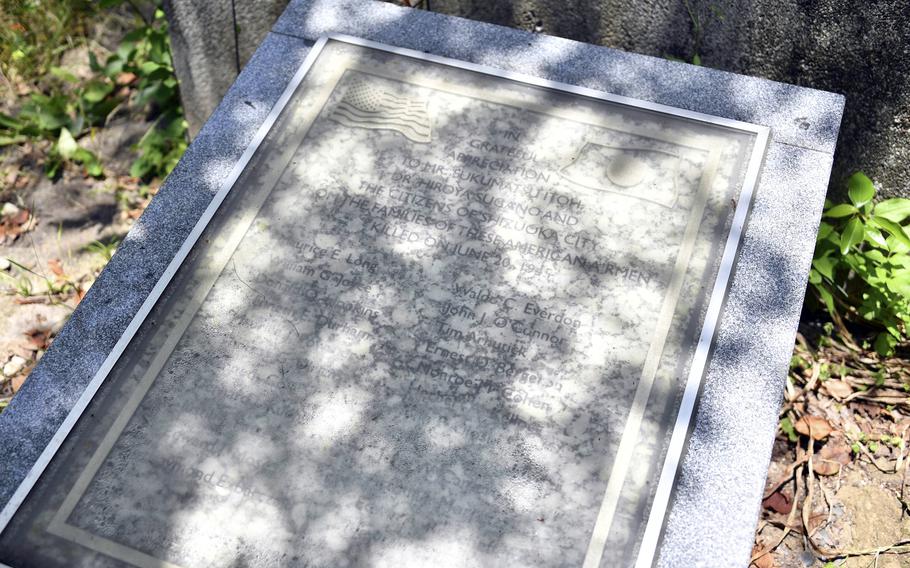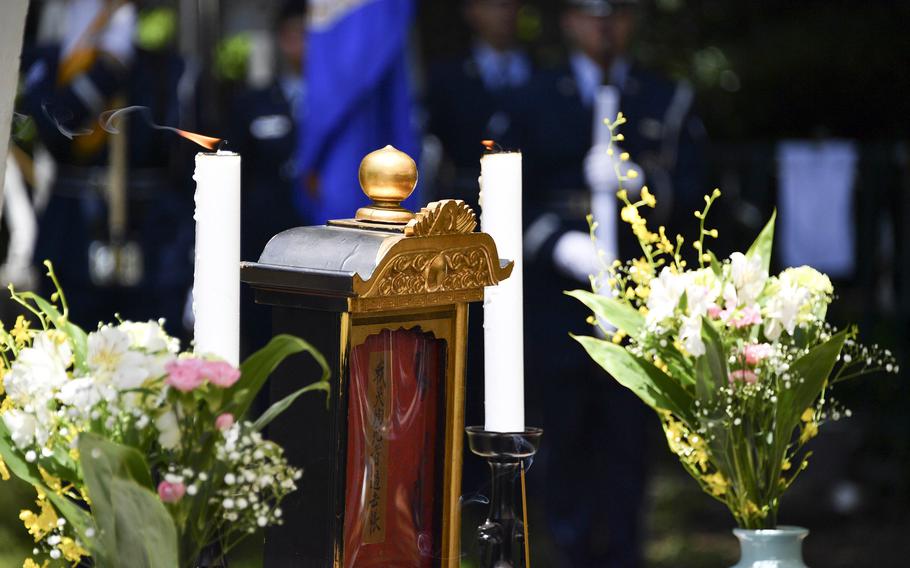
Col. Richard McElhaney, 374th Airlift Wing commander, attends a ceremony honoring fallen World War II airmen and Japanese civilians at Sengen Shrine in Shizuoka, Japan, June 21, 2025. (Juan King/Stars and Stripes)
SHIZUOKA, Japan — Around 60 American airmen trekked to a hilltop on Saturday to remember fallen bomber crews and Japanese citizens killed in a World War II air raid on this city 90 miles southwest of Tokyo.
The June 20, 1945, nighttime attack on Shizuoka — at the time the site of a Mitsubishi aircraft engine factory — involved 123 B-29 Superfortress bombers. The raid killed around 2,000 people on the ground and 23 U.S. airmen when two aircraft from the 314th Bombardment Wing collided.
On the raid’s 80th anniversary, a group of U.S. airmen from Yokota Air Base in western Tokyo climbed to the top of Sengen Hill in Shizuoka. There, they joined members of the Japanese Self-Defense Forces, American visitors and local Japanese for the ceremony.
Among the visitors was Thomas Rosenthal, whose father helped build some of the B-29s involved in the raid as a worker at the Martin bomber plant near Omaha, Neb.
“It’s powerful,” Rosenthal said at the ceremony, which brought forth memories of his late father, who died in 1990.

A blackened canteen bearing the fingerprints of a U.S. airman is displayed during a ceremony at Sengen Shrine in Shizuoka, Japan, June 21, 2025. (Juan King/Stars and Stripes)
The elder Rosenthal worked on the Enola Gay, which dropped the first atomic bomb on Hiroshima in August 1945.
The workers didn’t know about the plane’s intended mission, he said, adding: “They found out later what they had done.”
The bombers were the most advanced propeller-driven planes in the world in 1945, according to the National Air and Space Museum’s website.
“Designed to fly farther, faster, and higher than any other bomber, the combination of the B-29’s aerodynamic, structural, and propulsion innovations allowed it to carry 5,000 pounds of bombs to a target 1,500 miles away while cruising at 220 miles per hour at altitudes up to 30,000 feet,” the website states.
As sister cities, Omaha and Shizuoka have shared cultural and educational exchanges for 60 years, but the connection to the World War II air raid was rediscovered following a 2015 Omaha World-Herald story, said Steve Gerdes, president of the Omaha Sister City Association.
One of the B-29s involved in the Shizuoka raid was named City of Omaha, said Gerdes, who also attended the hilltop ceremony and was next headed to Hiroshima with Rosenthal to meet an atomic bomb survivor.

A monument at Sengen Shrine in Shizuoka, Japan, lists the names of Americans killed when two B-29 Superfortress bombers collided on June 21, 1945. (Juan King/Stars and Stripes)
It’s important to remember the fallen, Col. Richard McElhaney, commander of Yokota’s 374th Airlift Wing, told those gathered for the ceremony.
“If there is no remembrance, there is no healing, no learning and no development,” he said.
The ceremony included a Buddhist service and a flower presentation at the monuments. A canteen, filled with American bourbon, was poured over the B-29 monument in a tribute to the fallen.
The blackened canteen, bearing the fingerprints of a U.S. airman, was plucked from the bombers’ wreckage and preserved by Fukumatsu Itoh, a former local assemblyman.
Monuments erected on the hill by Itoh in 1967 honor the Japanese victims and U.S. airmen who perished in the raid.
A member of Yokota’s honor guard who attended the event, Tech. Sgt. Damian Hernandez, said it was a proud moment to present honors at the historical site.
“It’s rare that we get to be part of an off-base ceremony,” he said of the honor guard. “It’s something we are going to remember forever.”

A ceremony at Sengen Shrine in Shizuoka, Japan, June 21, 2025, honors B-29 crews and Japanese civilians killed in a bombing raid 80 years ago. (Juan King/Stars and Stripes)